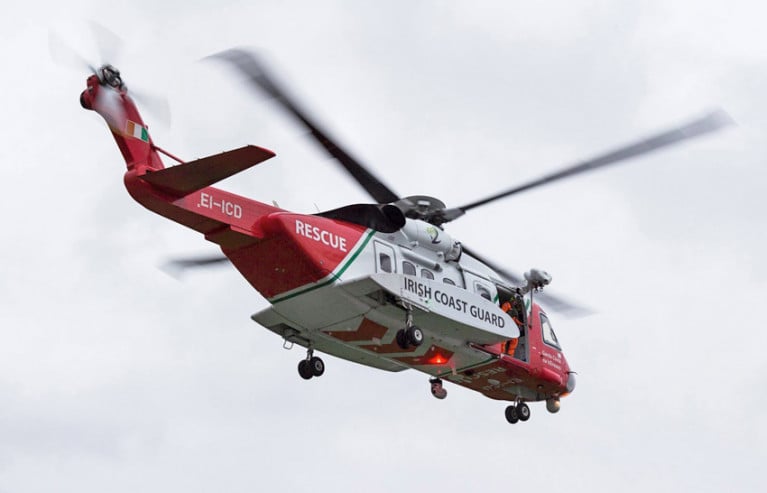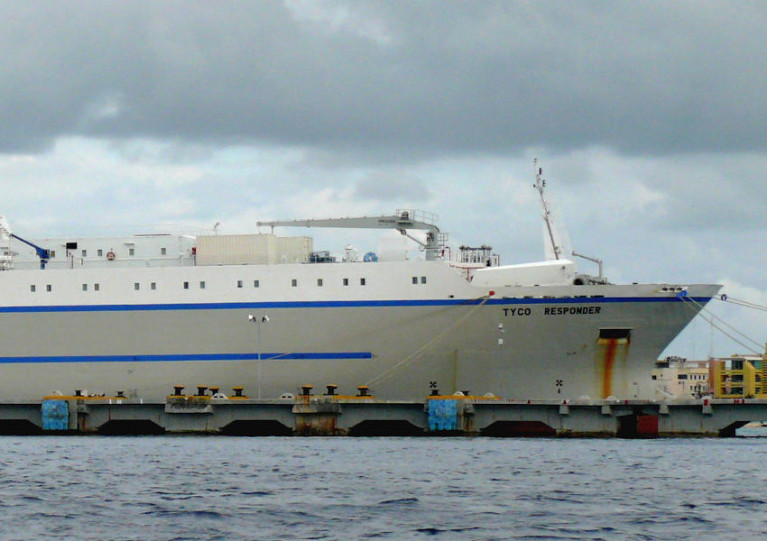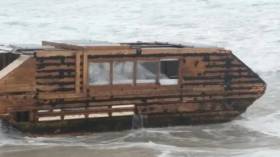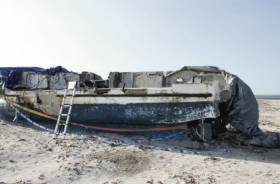Displaying items by tag: Mayo
Three Mayo Men Convicted Over ‘Very Serious’ Illegal Fishing Incident in July 2020
Three Mayo men have been convicted of false imprisonment, assault and obstruction as they attempted to evade fisheries officers from Inland Fisheries Ireland (IFI) at Belderrig Pier on the North Mayo coast two years ago.
At a sitting of Ballina District Court on 12 July this year, Judge Fiona Lydon also convicted the men of possessing illegally caught wild Atlantic salmon and nets, in charges brought by IFI. The charges of false imprisonment were brought by the Director of Public Prosecutions.
Daniel McHale, with an address of Belderrig Mor in Ballina, was sentenced to six months in prison, which was suspended for two years. Liam McHale of Carnrock in Belmullet was sentenced to four months in prison, also suspended for two years. Joachim McNulty, with an address of Belderrig Beg in Ballina, was sentenced to four months in prison, which was suspended for two years. The three men were also ordered to pay €2,500 each to charity.
The court heard evidence from Lonan O’Farrell, an inspector with IFI that on the evening of 15 July 2020, the men were approached by fisheries officers as they recovered their boat at Belderrig Pier on the North Mayo coast.
The fisheries officers suspected that the men had illegally caught wild Atlantic salmon and illegal gill nets on board but were obstructed and assaulted when they lawfully attempted to board the vessel.
A fisheries officer was subsequently assaulted and knocked overboard by one of the men, but two colleagues managed to board the vessel. When the fisheries officer swam safely back to the pier, the court heard that emergency services were contacted and An Garda Síochána quickly arrived on the scene.
With two fisheries officers still on board, the men took the boat out to sea and refused to obey orders to return the boat back to port. A short time later, the men agreed to bring the boat back to port and the fisheries officers were able to get back to the pier safely.
The boat, An Deiseach, was later detained in Porturlin Harbour where forensics and salmon scale samples were taken as evidence for the subsequent criminal prosecution. Fisheries officers, along with An Garda Síochana, seized three vehicles on the night belonging to the men in question.
Inspector Pat Armstrong, officer Brian Flannery and assistant inspector Michael Wilson, all with IFI, also gave evidence during court proceedings providing their accounts of the incident to Judge Lydon.
IFI chief executive Francis O’Donnell welcomed the convictions, saying it was one of the most serious incidents that the agency has come across.
“Thanks to the brave actions of our fisheries Oofficers, a major illegal fishing gang has been stopped and brought to justice,” he said. “However, in the course of doing their job to protect vulnerable fish species, such as wild Atlantic salmon, they were obstructed, assaulted and falsely imprisoned. This is not acceptable and cannot be tolerated in Irish society.
“This very serious case sends out a clear message to those involved in illegal fishing — we will use our full powers under the law to protect people doing their jobs and to prosecute offenders through the courts.”
O’Donnell also thanked An Garda Síochána and the Director of Public Prosecutions on behalf of IFI for their assistance in the case.
Fisheries Officers have nominated three charities — the Charlie Bird Fund, Western Alzheimer’s Association and the RNLI — to receive the three €2,500 donations.
Rescuers Await Low Tide to Retrieve Man Trapped in Mayo Sea Cave
A man has been rescued from a sea cave on the Co Mayo coast in which he has been trapped for close to 24 hours.
A multi-agency rescue operation had been awaiting low tide this afternoon (Sunday 18 September) to retrieve a man trapped in a sea cave at Downpatrick Head since the previous evening.
According to The Irish Times, the man in his 40s had been exploring the cave with a woman on Saturday (17 September) when they became trapped by the rising tide and were swept off a ledge by a wave surge.
The woman was taken from the water by kayakers who responded to the emergency and then to safety while the man climbed onto a ledge where he remained overnight.
Local gardaí say the man maintained contact with rescuers from the Irish Coast Guard and RNLI who were hopeful of gaining access to the sea cave with this afternoon’s forecast low tide.
RTÉ News reports that rescuers this afternoon brought the man to the mouth of the cave, where he was fitted with a buoyancy suit before being airlifted to hospital by the Sligo-based Irish Coast Guard helicopter Rescue 118.
This story was updated at 5pm with additional information.
Marine Notice: Subsea Fibre Optic Cable Installation Off Mayo Coast
SubCom will be carrying out subsea cable installation operations in Irish waters off the coast of Co Mayo, scheduled to begin Thursday 18 August.
A total of three vessels will be working on the America Europe Connect-2 project: the guard vessel DR Defiant (callsign MLAS6), day vessel MV James (callsign EI-TT-2) and CS Durable (callsign V7DI8).
The latter of these vessels will be engaged in pre-lay grapnel run and cable installation works.
In addition, the CS Durable will be restricted in manoeuvrability and all vessels operating within this area are requested to keep their distance and pass at minimum speed to reduce vessel wash.
Throughout operations, all three vessels will be displaying appropriate lights and shapes.
SubCom advises that these activities will take 39 days to complete, however the start date and duration of the activity is weather dependent.
Coordinates and a map of the survey are as well as contact details can be found in Marine Notice No 53 of 2022, attached below.
South Carolina Rubbish Bin Crosses Atlantic to Co Mayo Beach
A refuse barrel from South Carolina has been found washed up in an unexpected spot — on a beach more than 5,500km away in Co Mayo.
Myrtle Beach City Government shared their surprise email exchange with Keith McGreal, who discovered the blue barrel at the weekend while walking his local beach in Mulranny, between Clew Bay and Blacksod Bay.
McGreal contacted officials in Myrtle Beach — perhaps best known in this part of the world for its abundance of golf courses — going by the labels that were still fastened to the trash can despite its epic journey.
It’s suspected that following strong winds or a storm blew it into the North Atlantic, a favourable Gulf Stream current was responsible for taking the coastal rubbish receptacle so far off course.
“We typically remove trash containers from the beach before a hurricane, but this one apparently had a mind of its own,” the city said on social media, adding: “We’ve already had a city employee volunteer to come fetch it.”
A local community in eastern Co Mayo rallied to attempt to save as many as 13 common dolphins that live-stranded near Blacksod on Friday (13 August).
As Mayo IWDG’s Facebook reports, the family group comprising 13 dolphins — mainly mothers and calves with a large male — stranded at Tarmon Beach with the tide dropping.
Sadly three of the dolphins died before they could be helped, but the rest responded to being cooled with buckets of seawater by local volunteers assisting the area’s Irish Whale and Dolphin Group (IWDG) members.
As the tide was still dropping for over an hour, it was quickly decided to move the dolphins 2km by road to the slipway at Blacksod where they could be more easily immersed and cared for.
The local IWDG team used their new wheeled dolphin stretcher to transport the larger marine wildlife to a horse box, while the juveniles were carried in beach towels.
Once carefully released back into the water, all were seen to swim quickly and without obvious distress, and by 9pm the pod had left the area.
“Tarmon and the surrounding beaches on the east side of the Mullet Peninsula are notorious for common dolphins live-stranding due to the topography of the beaches,” Mayo IWDG said.
“The beaches are large flat expanses so during spring tides especially, the water can level can drop uniformly and recede up to 1km in parts. Common dolphins being an offshore dolphin species often get caught out on such difficult-to-navigate shallow terrain.
“When a dolphin live-strands it puts immense pressure on their bodies. They can become very disorientated and have muscle spasms from the stranding event making it difficult to swim, which is why this group were given recovery time at Blacksod before being released.
“Thanks again to everyone who helped out today; it was so humbling to see everyone work together to get this pod back to the sea.”
 Juvenile dolphins cooled down with wet towels and seaweed were given recovery time with their pod before release | Credit: Mayo IWDG/Facebook
Juvenile dolphins cooled down with wet towels and seaweed were given recovery time with their pod before release | Credit: Mayo IWDG/Facebook
Elsewhere, the IWDG reports on two separate strandings of Sowerby’s beaked whales in Co Galway. The first was found washed up on Inisbofin at the end of the week while the second was reported yesterday (Saturday 14 August) across the water in Cleggan.
Commenting on the former report, the IWDG said: “Beaked whales are not stranded that frequently but this individual had evidence of rope marks on its body.
“As [they are] an offshore deep-diving species we don’t expect beaked whales to get entangled in fishing gear or interact with offshore activity.
“Maybe these rope marks were not from fishing but some other source. Hard to tell, but without a full post-mortem examination the cause of death will remain speculative.”
The Red Bull Cliff Diving World Series is set to return to Ireland on 12 September, with Downpatrick Head in Co Mayo hosting the fourth stop on this year’s international circuit.
It’s one of the four new locations for the elite cliff diving competition, along with spots in France, Norway and the Caucasus.
It also marks the fifth Irish edition of the event — following three visits to Inis Mór in the Aran Islands and 2019’s contest in Dun Laoghaire, which attracted an estimated 145,000 spectators.
Elite divers representing 18 nationalities will take part in the 2021 series, which kicks off at Cap Dramont, south-west of Cannes on France’s Mediterranean coast, on 12 June.
The athletes then head to Oslo in Norway (14 August) and Mostar in Bosnia and Herzegovina before their Irish stop, continuing on to Polignano a Mare in southern Italy (26 September) and Baku in Azerbaijan (16 October).
The Irish Times reports that a 35-year-old man was airlifted to hospital with serious spinal injuries after a diving incident in Co Cork yesterday afternoon (Monday 1 June).
It’s understood that the man was diving from rocks near Nohoval Cove, between Kinsale and Crosshaven, when his foot caught and he landed on rocks.
Kinsale RNLI and gardaí attended the scene along with the Irish Coast Guard, which airlifted the casualty on board the Shannon-based Rescue 115 helicopter to Cork University Hospital.
Elsewhere, the search resumed this morning for a five-year-old boy believed to have fallen from a dinghy on Lough Mask.
RTÉ News reports that gardaí and the coastguard are searching the west side of the lough near Toormakeady in Co Mayo.
Mariners off the Mayo coast are advised to be on the lookout for two separate undersea operations from next week.
From Sunday 17 May, America Europe Connect 2 will be installing a subsea fibre optic cable in Irish waters to Oldhead, near Westport.
The works from the CS Responder involve a pre-lay grapnel run until Tuesday 19 May, followed by the cable installation from Wednesday 20 May to Tuesday 16 June, weather permitting.
Three other vessels will also be involved in these works, fun details of which are included in Marine Notice No 21 of 2020 attached below.
Meanwhile, Vermillion Ireland will begin a near shore inspection survey of the Corrib gas pipeline and umbilical from next Wednesday 20 May.
Details of the locations and vessels involved can be found in Marine Notice No 20 of 2020, also attached below.
Owner Of Mystery Mayo Houseboat Is Traced To Western Canada
The original owner of a mystery houseboat that washed up on the Mayo coast three years ago has been traced to western Canada, as RTÉ News reports.
The wooden vessel, which was fitted with solar panels, was recovered for restoration by locals with a view to becoming a tourist attraction for the North-West.
On an interior wall, it included a message from a ‘Rick Small’ offering it for free as a dwelling for homeless youth in Newfoundland.
It appeared that the houseboat was owned by the same Rick Small who gained some celebrity in Canada in 2014 for riding a solar-powered tricycle across the country.
And that’s since been confirmed by Canada’s CTV News, who traced Small (64) to his home in Victoria, British Columbia — and learned that he built the vessel himself for an intended voyage from Newfoundland around the Arctic.
CTV News has much more on the story HERE.
Small Boat Fishermen Reminded Of Requirements After MCIB Reports Into Fatal Incidents
New Marine Notices from the Department of Transport, Tourism and Sport (DTTAS) remind skippers and crew of small fishing vessels of the requirements set out in the relevant Code of Practice, following the official maritime reports into two fatal incidents off the West Coast last year.
Marine Notice No 38 of 2019 has been published in response to a fatal fishing boat capsize off Co Mayo in the spring of 2018, as previously reported on Afloat.ie.
One man died and two others were recovered some 16 miles off Eagle Island after their vessel, the FV Aisling Patrick, overturned on the afternoon of 10 April last year.
The report from the Marine Casualty Investigation Board (MCIB) clarifies that their vessel had begun to list to starboard and while that was being investigated, a wave struck from the port side and flooded the deck.
Before the skipper could complete a Mayday call, a second wave came from the port side that capsized the boat.
Only one of the three made it into the vessel’s liferaft, while the deceased “was in the water face down and did not make any attempt to swim or stay afloat”.
The upturned hull of the vessel drifted away but was reported off South Uist in Scotland some three weeks after the incident and later inspected.
While the MCIB report did not determine conclusively the cause of the capsize, it was noted that the vessel’s stability was affected due to water ingress — possibly from suboptimal pipe connections — and that the bilge alarm system did not give early warning to the skipper or crew.
Among other findings, it was noted that none of the three men on board was wearing a personal flotation device (PFD), and that the deceased — who had been returning to fishing after a number of years away — had not completed necessary training.
The Marine Notice reminds owners that any major repairs or modifications must comply with the Code of Practice (CoP), and that their vessel must be maintained and operated in accordance with its requirements.
A second Marine Notice, No 39 of 2019, pertains to the investigation into the sinking of a small boat while laying lobster pots off Connemara on 23 May 2018.
As reported here by Lorna Siggins earlier this month, the MCIB found that the boat’s owner, who died in the incident, had purchased a substantial amount of safety equipment — almost none of which was on board at the time.
The notice refers to the same CoP as well as to the advisory published this summer relating to the safety of small vessels engaged in pot fishing.
































































